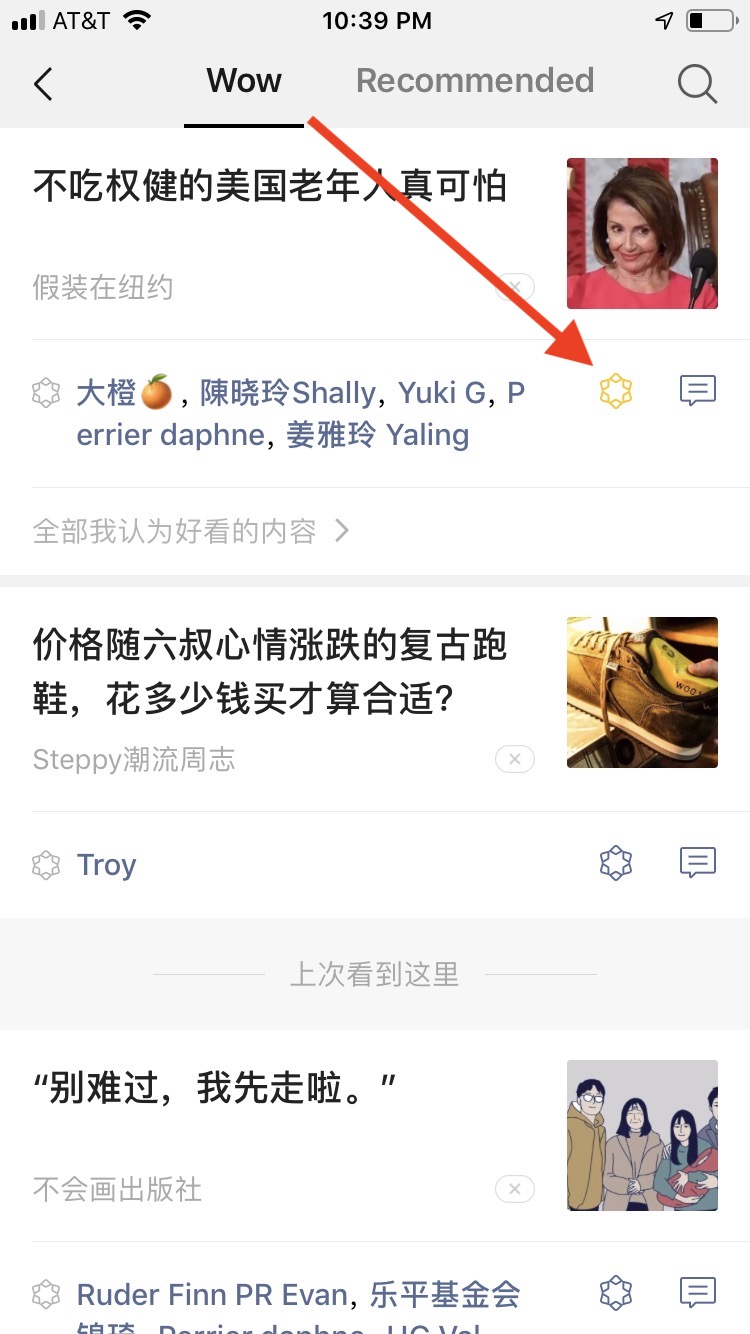How WeChat’s new ‘Wow’ and ‘Top Stories’ features have made the app worse
WeChat's pursuit of traffic with two new features, rolled out in its most recent update, has only highlighted the platform's problems of misinformation and "click farming."

“Pretending I’m in New York” (假装在纽约 jiǎ zhuāng zài niǔ yuē), a former journalist, has been posting about U.S. news for more than five years on his official WeChat account. Last month, he wrote about Nancy Pelosi’s election as the Speaker of the House of Representatives. “How old do you think this Congresswoman is?” he asked his readers. He pointed out how “seniors” in the U.S. — like the 78-year-old Pelosi — can still take powerful positions without being shy about their age, as many Chinese are.
Then, at the very bottom of the article, he wrote a line that never would have appeared just two months prior:
“May I bother everyone to click on ‘Wow’ on the bottom right corner?”
For the more than 8,500 of his readers who followed his order, his article titled “The American Senior Who’s Not Scared of Power” would have popped up in their “Top Stories” section, available for comment amongst followers.
“Wow” (好看 hǎokàn) and “Top Stories” (看一看 kàn yī kàn) were two features launched last December as part of WeChat 7.0, and they are altering the way users use the platform. In particular, self-publishers such as corporate accounts and individual content creators find themselves facing both opportunities and pitfalls. While they are happy about this new promotional channel as another way to sell advertisers on open rates, page views, and other statistics, it has already become yet another task content creators have to perform. Also, there’s risk that “Top Stories” will only further amplify WeChat’s problems of misinformation and fake data.
Lack of consumer education
Shortly after the launch, some early adopters like Lǐ Xīnyǔ 李鑫雨 only experienced inconvenience.
The 23-year-old Li updated WeChat as soon as she received a notification for 7.0 in December. Having been a new media editor for a food account for eight months, she spends an average of 12 hours on WeChat on workdays.
As Li had been considering leaving her job, she posted some thoughts on her personal account, then clicked “Wow” — a new button that appeared after WeChat’s update — on her post she titled, “End of the year, it’s time to leave.”
She thought “Wow” was the same as “Like,” a way to share posts to friends — and only friends — on WeChat Moments (which is similar to Facebook’s News Feed).
But Wow does not operate in the same way: Articles that are “Wow’ed” get filtered into a new section called Top Stories, which is viewable by everybody.
“My boss found out, and I was like, ‘How?’” Li said. Not only did her boss see her post, but everyone on her contact list could as well.
“Before the update, ‘Like’ didn’t really have a presence: nothing happens if you click it,” Gāo Xīnlíng 高馨凌, a social media executive at international digital agency The Egg, said. That’s not the case with Wow — something WeChat told its users in the App’s developer’s notes and in a user guide published by Tencent Media. But many users, like Li, were still confused.
“The two features are not as intuitive as voice message and texts, their user scenarios are limited,” Zhāng Yì 张毅, CEO of iiMedia Research Group, said. “It will take a long time for users to get used to them.”
Perpetuating misinformation
Readership of WeChat articles has been going down since 2016. According to Newrank, a WeChat data intelligence agency, page views of China’s top 500 WeChat accounts by traffic decreased 13.8 percent in 2018. This was worrying to Zhāng Xiǎolóng 张小龙, a.k.a. Allen Zhang, WeChat’s chief designer, as he noted in a rare appearance at WeChat Open Lecture Pro 2019 in January, a two-day conference hosted by the WeChat team to share what they’ve developed and their plan for the new year.

It was the need for more traffic that provided the impetus for the Top Stories section. But the readership boost comes with an increased risk of perpetuating misinformation. This is particularly true of WeChat: Since the inception of WeChat public accounts in early 2013, the platform has reportedly become the primary news source in China — as well as a hub of fake news. With a user base of over 1 billion monthly active users, there is a lot of opportunity for fake news to spread.
Part of the problem is, misinformation is profitable. Mī Méng 咪蒙, a former playwright, saw her WeChat account forcibly deactivated on February 22 because of an article written by her employee, which was accused of misinforming the public and condemned by state-media Xinhua. As someone known for her sensational content and clickbait articles (the likes of “She has a sex life at 83, what about you?”), she had more than 14 million followers on WeChat before the shutdown. With her audience base, she could have asked for 800,000 yuan ($118,694) — more than the cost of a Porsche — from advertisers for a native advertisement in the top column.
“Many WeChat articles feed into readers’ anxiety about work, parenting, and relationships,” said Lǐ Shuǎng 李爽, a researcher at the Tow Center for Digital Journalism of Columbia University. She said that was one of the reasons why articles like Mi Meng’s could garner so much attention and controversy.
WeChat amplifies messages, in the form of articles, within one’s friends on the App, which is dangerous when those messages are not accurate.
“Recommended articles by friends have an extra layer of credibility,” Li Shuang said.
That layer of credibility, in the new Top Stories section, has been removed.
Fake stats
According to Zhang Yi, who runs a research group that consists of a dedicated team studying China’s social media statistics through big data, fake data — page views achieved via machines and manual labor — in WeChat’s advertising space is another issue that version 7.0 has yet to resolve — or even try to.
Pumping followers on social media is hardly a China-only phenomenon. One can buy fake Twitter followers and fake YouTube views, for instance — though those platforms have been proactive about purging suspicious accounts. To an extent, WeChat has begun to as well, but the problem is one of scale. While Twitter has 255 million monthly active users worldwide, WeChat has three times more, at 1.04 billion. It’s simply easier to inflate click rates on WeChat.
In September 2017, iiMedia published a report on the fake data phenomenon, revealing that 86.2 percent of WeChat public accounts have purchased page views from service providers to fool readers and advertisers — what is called click farming (刷量 shuāliàng). Zhang said that if “Wow” is included in WeChat’s future advertising model, fake data is unavoidable. “It might be harder for machine algorithms to infiltrate,” Zhang said, “but you can always reward those who like the post for you.”
In fact, fake data has become a part of WeChat’s advertising ecosystem. “Small advertisers usually work with agencies, because Tencent offers volume-based rebates,” Zhang Yi said. The higher the volume of ad spend, the higher the rebate.
Li, the new media editor, said her company started buying fake page views in January, especially for sponsored articles. “We would get at least 10,000 views for the latter, and three to four thousand for our own articles,” she said.
The demand for fake data from self-publishers, advertisers, and agencies is fed into Tencent’s advertising arm, Tencent Social Ads, which made 11.1 billion yuan ($1.7 billion) in 2018’s third quarter, with a 61% year-on-year increase.
“There is a saying among advertisers: You’d rather work with accounts with 10,000 fake views than those with 5,000 real views,” Li said. “Because the boss only wants to see numbers, not impact.”
As for her personal use, “I would never click on ‘Wow’ again after that incident,” she said. “Except for my company’s articles.”
![]()






